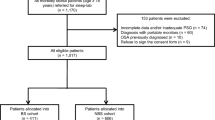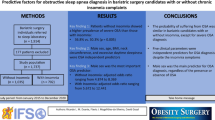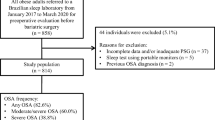Abstract
Purpose
Bariatric surgery (BS) is a treatment option for morbid obesity leading to substantial and sustained weight loss in adults. As obstructive sleep apnea (OSA) is highly prevalent in obese subjects and may increase the perioperative risk, screening for OSA is recommended prior to BS. In clinical routine, BS is performed more frequently in women. Therefore, we sought to assess the gender-specific performance of four sleep questionnaires (Epworth Sleepiness Scale (ESS), Fatigue Severity Scale (FSS), STOPBang, and NoSAS) to predict moderate to severe OSA in the morbidly obese population.
Material and Methods
We applied all four questionnaires to patients scheduled for BS with polygraphic OSA screening at our institution between 2012 and 2015 and performed gender-specific sensitivity analyses.
Results
We included 251 bariatric patients (76% female, median age 39 years, median BMI 42.0 kg/m2). OSA (AHI > 5/h; AHI > 15/h) was present in 43% (females 35%, males 68%; p < 0.001) and 21% (females 13%, males 45%; p < 0.001). STOPBang and NoSAS performed markedly better than ESS and FSS. With the exception of the ESS, all sleep questionnaires allowed better OSA prediction in women than in men.
Conclusion
In obese patients scheduled for BS, a gender-specific difference was observed in the performance of the evaluated OSA screening questionnaires. This needs to be considered when these questionnaires are used. Our results underline the need for better gender-specific OSA screening algorithms in morbidly obese patients.

Similar content being viewed by others
References
Ravesloot MJL, van Maanen JP, Hilgevoord AAJ, et al. Obstructive sleep apnea is underrecognized and underdiagnosed in patients undergoing bariatric surgery. Eur Arch Otorhinolaryngol. 2012;269:1865–71. https://doi.org/10.1007/s00405-012-1948-0.
Buchwald H, Avidor Y, Braunwald E, et al. Bariatric surgery a systematic review and meta-analysis. JAMA. 2004;292:1724–37. https://doi.org/10.1001/jama.292.14.1724.
Kolotkin RL, LaMonte MJ, Walker JM, et al. Predicting sleep apnea in bariatric surgery patients. Surg Obes Relat Dis. 7:605–10. https://doi.org/10.1016/jsoard201104.226.
Duarte RL de M, Magalhães-da-Silveira FJ. Factors predictive of obstructive sleep apnea in patients undergoing pre-operative evaluation for bariatric surgery and referred to a sleep laboratory for polysomnography. J Bras Pneumol publicaçao Of da Soc Bras Pneumol e Tisilogia. 2015;41:440–8. https://doi.org/10.1590/S1806-37132015000000027.
Fassbender P, Herbstreit F, Eikermann M, et al. Obstructive sleep apnea—a perioperative risk factor. Dtsch Arztebl Int. 2016;113:463–9. https://doi.org/10.3238/arztebl.2016.0463.
Gross JB, Bachenberg KL, Benumof JL, et al. Practice guidelines for the perioperative management of patients with obstructive sleep apnea: a report by the American Society of Anesthesiologists Task Force on Perioperative Management of patients with obstructive sleep apnea. Anesthesiology. 2006;104:1081–93–8.
Fried M, Yumuk V, Oppert JM, et al. Interdisciplinary European guidelines on metabolic and bariatric surgery. Obes Surg. 2014;24:42–55. https://doi.org/10.1007/s11695-013-1079-8.
Johns MW. Reliability and factor analysis of the Epworth Sleepiness Scale. Sleep. 1992;15:376–81.
Valko PO, Bassetti CL, Bloch KE, et al. Validation of the fatigue severity scale in a Swiss cohort. Sleep. 2008;31:1601–7.
Chung F, Yegneswaran B, Liao P, et al. STOP questionnaire: a tool to screen patients for obstructive sleep apnea. Anesthesiology. 2008;108:812–21. https://doi.org/10.1097/ALN.0b013e31816d83e4.
Marti-Soler H, Hirotsu C, Marques-Vidal P, et al. The NoSAS score for screening of sleep-disordered breathing: a derivation and validation study. Lancet Respir Med. 2016;0:310–8. https://doi.org/10.1016/S2213-2600(16)30075-3.
Sareli AE, Cantor CR, Williams NN, et al. Obstructive sleep apnea in patients undergoing bariatric surgery—a tertiary center experience. Obes Surg. 2011;21:316–27. https://doi.org/10.1007/s11695-009-9928-1.
Khan A, King WC, Patterson EJ, et al. Assessment of obstructive sleep apnea in adults undergoing bariatric surgery in the longitudinal assessment of bariatric surgery-2 (LABS-2) study. J Clin Sleep Med. 2013;9:21–9. https://doi.org/10.5664/jcsm.2332.
Sharkey KM, Orff HJ, Tosi C, et al. Subjective sleepiness and daytime functioning in bariatric patients with obstructive sleep apnea. Sleep Breath. 2013;17:267–74. https://doi.org/10.1007/s11325-012-0685-3.
Sharkey KM, Machan JT, Tosi C, et al. Predicting obstructive sleep apnea among women candidates for bariatric surgery. J Women's Health (Larchmt). 2010;19:1833–41. https://doi.org/10.1089/jwh.2009.1859.
Berry RB, Budhiraja R, Gottlieb DJ, et al. Rules for scoring respiratory events in sleep: update of the 2007 AASM manual for the scoring of sleep and associated events. Deliberations of the Sleep Apnea Definitions Task Force of the American Academy of Sleep Medicine. J Clin Sleep Med. 2012;8:597–619. https://doi.org/10.5664/jcsm.2172.
DeLong ER, DeLong DM, Clarke-Pearson DL. Comparing the areas under two or more correlated receiver operating characteristic curves: a nonparametric approach. Biometrics. 1988;44:837–45.
R: The R Project for Statistical Computing. https://www.r-project.org/. Accessed 24 Apr 2016.
Robin X, Turck N, Hainard A, et al. pROC: an open-source package for R and S+ to analyze and compare ROC curves. BMC Bioinformatics. 2011;12:77. https://doi.org/10.1186/1471-2105-12-77.
Dixon JB, Schachter LM, O’Brien PE. Predicting sleep apnea and excessive day sleepiness in the severely obese: indicators for polysomnography. Chest. 2003;123:1134–41.
Peppard PE, Young T, Palta M, et al. Longitudinal study of moderate weight change and sleep-disordered breathing. JAMA. 2000;284:3015–21.
Quintana-Gallego E, Carmona-Bernal C, Capote F, et al. Gender differences in obstructive sleep apnea syndrome: a clinical study of 1166 patients. Respir Med. 2004;98:984–9.
Chung F, Yang Y, Liao P. Predictive performance of the STOP-Bang score for identifying obstructive sleep apnea in obese patients. Obes Surg. 2013;23:2050–7. https://doi.org/10.1007/s11695-013-1006-z.
Mohsenin V. Effects of gender on upper airway collapsibility and severity of obstructive sleep apnea. Sleep Med. 2003;4:523–9.
Punjabi NM. The epidemiology of adult obstructive sleep apnea. Proc Am Thorac Soc. 2008;5:136–43. https://doi.org/10.1513/pats.200709-155MG.
Wimms A, Woehrle H, Ketheeswaran S, et al. Obstructive sleep apnea in women: specific issues and interventions. Biomed Res Int. 2016;2016:1764837–9. https://doi.org/10.1155/2016/1764837.
Author information
Authors and Affiliations
Corresponding author
Ethics declarations
Conflict of Interest
The authors declare that they have no conflict of interest.
Ethical Approval
This study was approved by the local ethics committee (KEK 2017-00772).
Informed Consent
Due to the retrospective nature of the study, informed patient consent was waived.
Rights and permissions
About this article
Cite this article
Horvath, C.M., Jossen, J., Kröll, D. et al. Prevalence and Prediction of Obstructive Sleep Apnea Prior to Bariatric Surgery—Gender-Specific Performance of Four Sleep Questionnaires. OBES SURG 28, 2720–2726 (2018). https://doi.org/10.1007/s11695-018-3222-z
Published:
Issue Date:
DOI: https://doi.org/10.1007/s11695-018-3222-z




